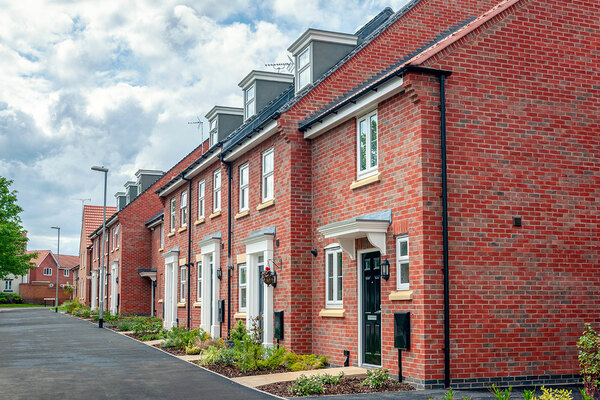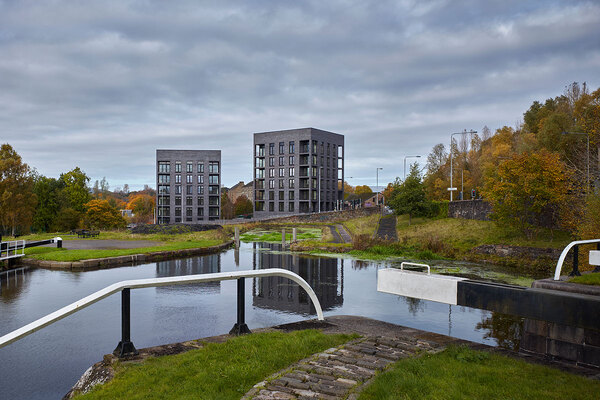You are viewing 1 of your 1 free articles
What does the new ‘design charter’ for homes in the West Midlands mean for the sector?
The West Midlands Combined Authority has developed a pioneering blueprint for good building. Lucie Heath reports. Picture by Getty
Barcelona, Balenciaga and the iPad are all things people may think of when asked for examples of great design. Over the years, some housing developments have earned a place on this list – think the Barbican or, more recently, the Stirling prize-winning Goldsmith Street development in Norwich.
However, these well-designed estates are often the exception rather than the rule.
Just as common are developments that have seen their designs or layouts exacerbate some social issues, leading to demolition just decades after they were built.
It is through these mistakes that housing associations and developers have started to understand the importance of design. ‘Good design’ and ‘placemaking’ have long been buzzwords in the sector, but their overuse has led to confusion over what they actually mean.
It is within this context that the West Midlands Combined Authority (WMCA) has launched its design charter – the first of its kind in the UK. The charter, which was developed through a series of workshops attended by the 12 authorities in the WMCA, defines what good design looks like and acts as a blueprint for anyone looking to gain planning permission in the region.
“We went from a place where I think it’s safe to say there was a bit of scepticism about what a design charter could do to a real, genuine collaboration,” explains Louise Wyman, design lead at the WMCA and director of strategy and engagement at Homes England, from which she is on secondment.
Over a period of six months, the group whittled down “hundreds of pages” of ideas into 12 core principles, grouped into six main themes: character, connectivity and mobility, future-readiness, health and wellbeing, engagement and stewardship, and delivery.
While themes such as connectivity and mobility – aka more bikes and fewer cars – are fairly self-explanatory, others require more explanation. Character, for example, is not just about building houses that look good but building houses that demonstrate a deep understanding of the local area.
“I’ve seen a house in Oxford that looks just like a house in Hull and that can’t be right, so we’ll be looking for schemes that demonstrate regional character,” Ms Wyman explains.
But not only is this about fitting in aesthetically, by using dark bricks in Birmingham and pale bricks in Cambridge, for example, it is also about designing buildings that reference the past and the traditions in which they are built.
A by-product of this is that developers will be encouraged to use local materials, rather than transporting them over long distances. This ties into another theme, which Ms Wyman admits will be the hardest to achieve: future-readiness.
Last week, the WMCA published its #WM2041 report, which included detailed recommendations for achieving carbon neutrality by 2041. This charter is a signal that developers looking to achieve planning permission must take these goals seriously.
“We’ve got to do more – and we know this as an industry – around climate resilience, low-carbon development and technological resilience,” Ms Wyman says.
“I think there’s quite a lot of greenwashing out there. We’re not interested in greenwash – we’re interested in real, transformational change in this region that meets those agendas,” she adds.
While the charter may seem great on paper, how likely is it that these principles will have a real impact on planning in the region? The charter is not statutory and it is therefore up to each local authority to incorporate it into their planning policies.
Ms Wyman says she sees the charter as “more carrot and less stick”, but her hope is that including the local authorities in the charter’s development means they are more likely to adopt the charter.
The six principles of the West Midlands Combined Authority's design charter
Character
Developers must demonstrate an understanding of the local context and provide benefit to local communities.
Community and Mobility
Proposals should integrate into existing and planned transport networks while also promoting walking, cycling and public transport use.
Future Readiness
Developments need to make clear, specific commitments to carbon reduction and be adaptable to the changing requirement of communities.
Health and Well-being
Well-being and good mental health should be promoted through developments and access to nature, and spaces should be provided for physical activity.
Engagement and Stewardship
Key stakeholders should be able to influence design from an early stage, while public spaces should be designed to enhance civic pride.
Delivery
Ultimately, developers are expected to promote and deliver genuine social value throughout the development and construction process.
Stratford-on-Avon District Council is the first of WMCA’s member authorities to endorse the charter and will use it to inform planning decisions and policy development.
But some may be less willing to embrace the charter’s principles and Ms Wyman admits there was a degree of “scepticism” at the start.
One obvious worry is that having to hit high design standards could slow development. But Ms Wyman dismisses this, arguing that providing this level of guidance and clarity to developers should actually speed up planning.
“I think in the old days, not so much now, people would have said: ‘Well, design costs money, I’m not going to do it,’” says Ms Wyman. “Those arguments feel like a long time ago to me, but there’s still a journey to do around the country.”
Luckily, this focus on design isn’t confined to the West Midlands. Ms Wyman points out that Homes England wouldn’t have invested a year of her time in the project if it wasn’t serious about pushing these ideas nationally.
Design has been high up on the government’s agenda since the Building Better, Building Beautiful Commission was set up in 2018 to advise the government how to promote better designed homes. The commission’s first report, Creating Space for Beauty, which was published last year, said that beauty should become a condition of government funding.
Following this, the government announced in September that it was planning to develop a new national design guide for homes, with local authorities across the UK expected to design their own guides in line with national standards.
Ms Wyman and her team have already been approached by their counterparts in cities including Bristol, Liverpool and Manchester.
“This has been a great region to incubate these ideas… but [the charter] is a national exemplar now. They’re all looking at what we’re doing and this region is first, but you will see more of this over the next 12 months,” she says.
More on the Addison Act
How George Clarke is aiming to end the housing crisis with his new TV show Architect George Clarke has long been a passionate campaigner for more – and better – council housing. As Inside Housing celebrates 100 years of the Addison Act, Martin Hilditch meets a man on a mission
100 Years of Council Housing: your tweets from week three Our favourite #100yearsofcouncilhousing tweets from the past seven days as our Addison Act activity moves into its fourth week
Nottingham's new wave Robyn Wilson goes to Nottingham to see what the next generation of council homes are set to look like.
If we’re going to have another 100 years of council housing, Right to Buy has to go The Right to Buy is having a devastating effect on the availability of council housing in this country and must be scrapped, writes Lee Sugden
What next for council housing? To celebrate the centenary of the Addison Act, Inside Housing asks a group of housing experts what can be learned from its legacy (sponsored)
Thatcher's legacy: a brief history of the Right to Buy An engine for social change or a handbrake on council development? We look at why the Right to Buy is as divisive as ever #ukhousing
A history of council housing: a timeline From the Addison Act to prefabs, slum clearance and the Right to Buy, council housing in the United Kingdom has a long and colourful history. Carl Brown looks at how it has evolved over time
Council housing: the key to a more equitable and dynamic society As the 100th anniversary of the Addison Act approaches, we publish an abridged extract of a book by Chris Matthews chronicling the history of council housing in Nottingham
Addison’s framework was scrapped but its legacy is more important than ever The fortunes of council housing have ebbed and flowed ever since Addison’s programme was abruptly halted in 1921, writes Jules Birch
Hulme: the redevelopment project that changed regeneration The redevelopment of Hulme in Manchester kick-started a new approach to regeneration in the UK – and the careers of some of housing’s best-known figures. Martin Hilditch joins them on a step back in time with lessons for today.
100 Years of Council Housing: your tweets from week two We pick our favourite #100yearsofcouncil housing tweets over the past week
Memories of council housing: the human legacy of the Addison Act As the centenary of the first council houses approaches, Peter Apps hears from some of the people who have lived in them in the decades since
Many of the sector’s current leaders began their journeys in council teams One hundred years of council housing has delivered a generation of sector leaders as well as millions of council homes, writes Mervyn Jones
Stevenage: home of the new town revolution Stevenage was the first of the post-war ‘new towns’. Gavriel Hollander visits the town to see how it has changed.
100 Years of Council Housing: your tweets from week one Inside Housing has been encouraging councils to say what they are doing to build homes and to mark 100 years of council housing. Here we feature a selection of your tweets
Kit Malthouse: 'Council housing is coming back with a vengeance' Housing minister Kit Malthouse tells Martin Hilditch why growing numbers of councils are looking to get back into development
Sea Mills: we visit one of the first estates to benefit from the Addison Act Social historian John Boughton visits a place in Bristol still cherished today
The Housing Podcast: is council housebuilding about to make a comeback Nearly 100 years after the introduction of the Addison Act, which kick-started the building of the first council estates in the UK, the Housing Podcast team examines the state of council housebuilding today
Why the 100th anniversary of the Addison Act should spark a council housing comeback Let’s make 2019 the start of a renaissance of council housing, writes Martin Hilditch
Are new borrowing freedoms sparking a revival of council housebuilding? The Addison Act marked the birth of council housebuilding. A century later, could recent financial freedom spark a renaissance? Nathaniel Barker investigates.
How Cornwall is taking inspiration from Christopher Addison Cornwall Council is one of many keeping the legacy alive, writes Kate Kennally.
The Addison Act - celebrating 100 years of council housing This year marks the 100th anniversary of the Addison Act – which paved the way for council housebuilding on a large scale. Inside Housing has a whole month of special activity planned and we want to hear your stories
The 100-year anniversary of the Addison Act means it’s time to talk about council housing Let’s use the 100th anniversary of council housing as we know it to flag up some of the great work that’s been done – and kick-start a conversation about the future, writes Martin Hilditch
London must recapture the housebuilding ambition of the Addison Act Councils are committed to development but are still facing unfair restrictions, writes Darren Rodwell of London Councils
Marking 100 years since the ‘Addison Act’ Professor Mark Swenarton writes about the Homes Fit for Heroes Centenary Conference












